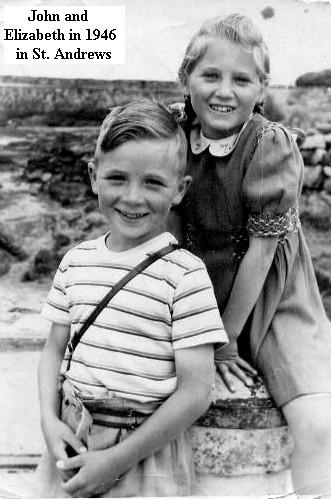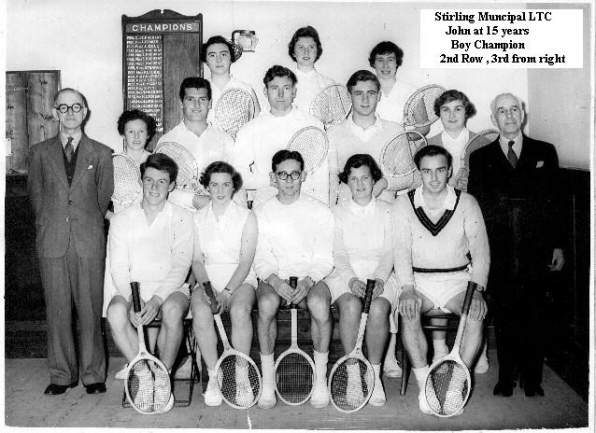1944-1949
Banknock Village – ‘Anyone for Tennis?’
The school
summer holidays in July 1946 took in a planned fortnight’s stay
in St. Andrews. I say ‘planned’ because it was foreshortened by
a ‘clothing focused’ burglary of Schoolhouse, Banknock while we
were away. The detectives later told us that, due to previous
war-time rationing restrictions on clothes, the Glasgow criminal
fraternity were busy supplying the black-market at the ‘Barrows’
on Glasgow Green with all apparel they could lay their hands on.
In the event, we were left with only the clothes we had taken
with us on holiday. Dad was worst hit because all his good suits
‘went west’ except for the ancient ‘plus-fours’ which he
often wore but others would only have deemed wearable on
a golf course a la Henry Cotton! Apart from being so
out-of-fashion, we were told that these baggy anachronisms would
have been too easily identified as stolen goods by police on the
look-out in the areas where the burglars’ fences operated in the
city.
However, all
these traumas apart, we had a great holiday, albeit shorter than
expected, in the city home of the Royal and Ancient Golf Club.
Playing the Old Course did not interest my dad, but the same
could not be said for our frequenting the lovely enclosed
‘Step-Rock salt water swimming pool arena with its nice wee
beach and paddling for us wee folks. Mornings tended to be spent
shopping and site-seeing, before we all played a daily game of
putting on the magnificently smooth, yet delightfully undulating
putting-greens near the West Sands prior to taking lunch in our
very comfortable guest-house opposite the West Port. Afternoons
were happily passed, swimming then shivering, paddling and
sand-castle building, picnicking and ice-creaming, at the
sheltered Step-Rock sun-trap.
Then one
evening my mum said that she wanted to go for a walk along to
Kinburn Park to see the tennis. The lure for my sister Elizabeth
and I to go along with this was the presence there of swings and
a shute. As it happenned, however, I was entranced by the game
called tennis that all these folks in beautiful ‘whites’ were
playing, and, as was my wont, I mentally decided that this would
be a game that I would love to try to play when I got back to
the village. I also knew that A.J. Mee’s Encyclopedia would no
doubt supply me with its rules and many other relevant facts as
well!

Our good
friend, a local contractor, John McLean, duly came east in his
big car to pick us up and whisk us home in the wake of the
‘break-in’ at the schoolhouse – incidentally, I first learned
about ‘double-declutching’ the car gear-box on that return
journey – but, apart from all the mess in the house left by the
burglars, an almost unbelievable co-incidence occurred when I
poked my head round the door of the cloak-room cum ‘glory hole’
walk-in cupboard under the schoolhouse stairs. There – before my
very eyes – as if saying, ‘pick us up and play with us’ - were
my parents’ two ancient tennis racquets, and from my Kinburn
Park experience, I immediately had a fair idea of to what use I
could put them!
So, as soon as
things got back to normal – with mutilated doors and broken
windows etc. repaired or replaced – I studied the encyclopedia,
found as many tennis or rubber balls as I could, and headed off
to the school playground with mum’s racquet to practise hitting
balls against any wall that seemed reasonably clear of windows.
The school had been built on a fair slope, so the gable walls in
the rear playground, rose about four feet higher off the ground
than those at the front street end. This meant that, unless I
was very rash, the two windows on the sand-stone wall where I
had chosen to experiment, might be relatively safe from harm.
Wishful thinking, yes, but they indeed survived many a near miss
in the rest of that summer, as well as in other years’ many,
many summer hours spent on forehand and backhand (less
controllable!) driving, lobbing and chipping against that wall.
As chalking
the stone walls of the school was totally forbidden, I was only
allowed to stone-scratch a few marks at the correct height to
indicate where a tennis net would reach – although this target
became more identifiable because of the building’s construction
comprising huge well pointed and indented stone blocks. This
chiselled indenting of the stone blocks of course made the
directions taken by rebounding balls less predictable, which,
while leading to a certain degree of frustration, also, as I
became more skilful, provided excellent preparation for dealing
with even the most inscrutable opponent’s returns in future
playing of the real game.
In addition
the playground was ‘multi-purpose’, as it housed two large
shelters for pupils to use in wet weather! Thus I could also
practise against their supporting walls in inclement weather,
albeit in a more limited fashion … until … because the balls
would become sodden from my quite often sclaffing them out
sideways into the wet playground, the gut strings of my mum’s
old racquet would burst and thus cause temporary deprivation
until repaired in Palmer’s sports shop in Port Street, Stirling.
Luckily we made the long journey to Stirling quite often by bus
to visit my Grandma Henderson, so the sports’ shop became an
attainable (essential in my eyes) port of call!
Meanwhile, the
idea of competitive tennis matches over a net became another
priority objective, especially when, I, as a very normal selfish
‘infant terrible’, knew that I would win, mainly because neither
my sister nor Robin, as prospective opponents, had practised as
hard as I had. However, first things first – ‘Bumpy Ibrox’ had
to be converted into a tennis court, and consequently some form
of barrier had to be manufactured as a tennis ‘net’. In the
event, strategically placed ‘bean-bags’ indicated where the
court ‘lines’ were – a first cause of many ‘out/in’ arguments in
later games. The second cause for umpteen debates came from the
improvised barrier in the middle of the court. What we invented
for this ‘net’ was merely a bit of mum’s spare clothes’ rope
stretched over and between two up-ended ‘orange-boxes’ weighted
down with bricks. (c.f. The boxes were obtained from the garden
as shown behind me in the photograph with the ‘cuv’ at my feet
in Chapter One). This time the disputes were of the, ‘yes it’s
over, no it’s under’ variety. Sad to say, in due course, for
more reasons than just mere squabbling about decisions,
competitive tennis was reluctantly abandoned. Why? Well, actual
tennis courts have high protective net fencing around their
peripheries. Unfortunately we had no such fencing. Indeed, worse
still, as additional hazards, we not only had a hay or corn
field at one end into which many a ball regularly disappeared
never to be seen again, but also there was an impenetrable
hawthorn hedge at the other end whose owners on its far side
soon proved to be extremely unwelcoming people to approach with
the request, ‘Can we please go down into your garden and get our
ball back’!

Although this
exciting competitive experiment was deemed another relative
failure, appetites for the game had been whetted, as witnessed
by the fact that both Elizabeth and I not only continued to
practise tennis against school walls in Banknock, and later in
Cambusbarron and Bannockburn, but also became club champions in
our teens at the Municipal LTC within the King’s Park, Stirling.


